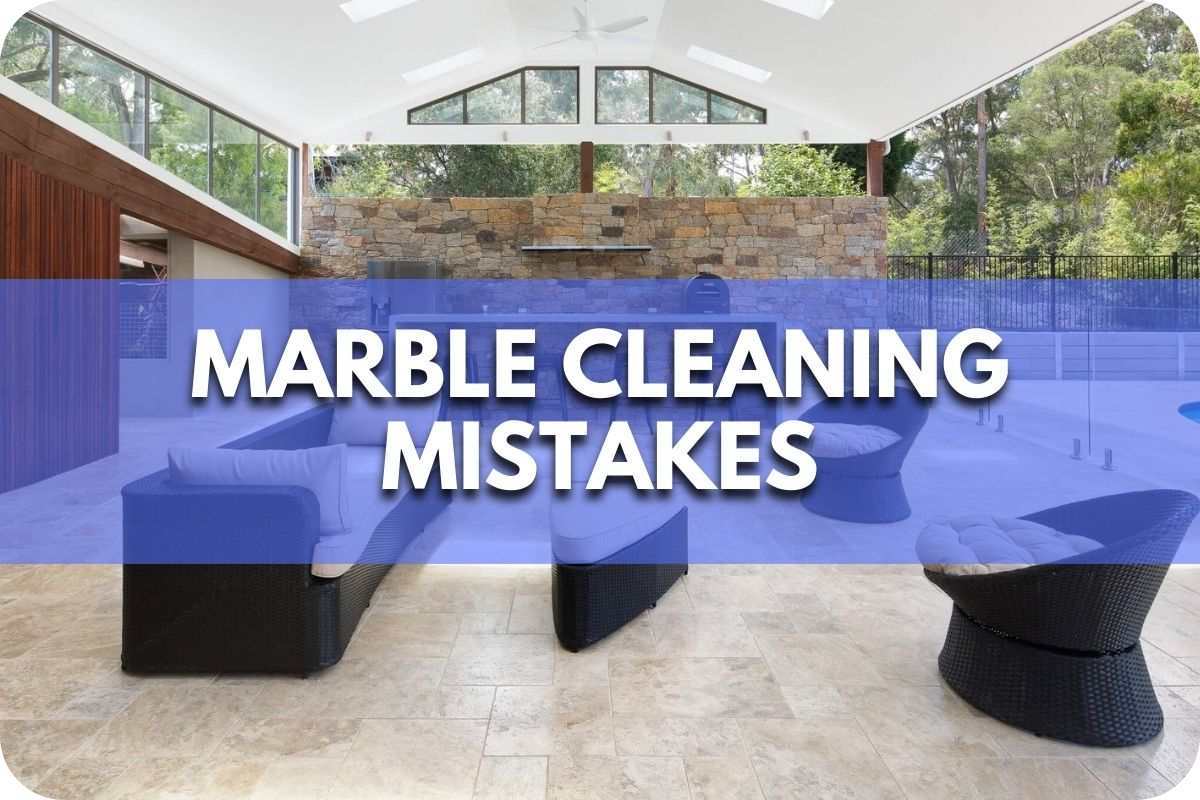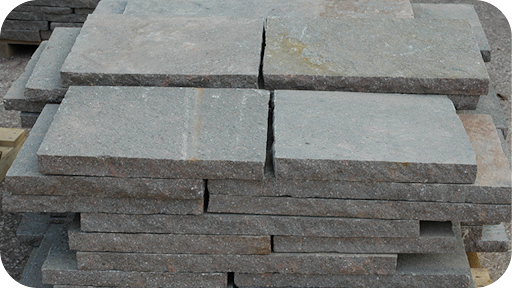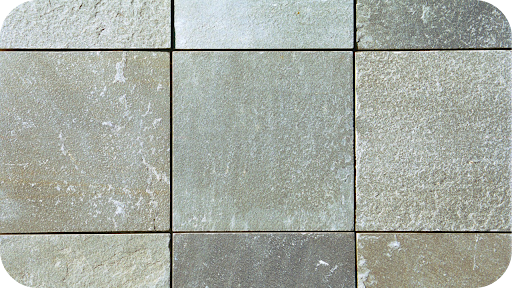
Marble is a beautiful and luxurious material, but it’s also delicate and prone to damage from improper cleaning methods.
Using the wrong products or techniques can leave your marble surfaces etched, stained, or dull, ruining their elegant appearance and potentially costing you a fortune in repairs or replacements.
Fortunately, avoiding these common marble cleaning mistakes allows you to keep your marble looking pristine for years.
Common Marble Cleaning Mistakes
1. Using Harsh Chemical Cleaners 
One of the most damaging mistakes you can make with marble is using harsh chemical cleaners. Here’s why:
- Acidic Cleaners: Products like vinegar, lemon juice, and many all-purpose cleaners contain acids that etch marble. This etching dissolves the surface, creating dull spots, loss of shine, and increased proneness to staining and scratches.
- Abrasive Cleaners: Even seemingly mild cleaners with scrubbing particles can scratch marble’s delicate surface. These scratches dull the finish, making the stone susceptible to further damage.
Gentle Alternatives for Marble Cleaning
Instead of harsh chemicals, opt for these safe and effective cleaning solutions:
- Dish Soap and Warm Water: A few drops of mild dish soap in warm water create a gentle cleaner that is ideal for cleaning marble surfaces daily.
- Stone-Specific Cleaners: Formulated with a neutral pH, these cleaners are designed to safely lift dirt and grime from marble.
- Baking Soda Paste: For tougher stains, make a paste of baking soda and water. Apply it to the stain, let it sit briefly, and gently wipe away.
2. Ignoring Spills and Stains
The importance of promptly addressing spills and stains on marble surfaces.
- Marble’s porous nature allows liquids to penetrate quickly, making stains more challenging to remove when left unattended.
- Immediate action is crucial to prevent deep-set stains that can be difficult or impossible to eliminate.
Tips for removing common stains from marble, such as wine, coffee, and oil.
- Blot, Don’t Wipe: Blotting spills with an absorbent cloth prevents them from spreading.
- Wine, Coffee, and Tea: A mixture of ammonia and hydrogen peroxide can often remove these stains. Apply the mix, let it sit for a few minutes, and wipe clean.
- Oil: Baking soda and water paste effectively draws out oil stains. Apply, cover with plastic wrap, and leave for several hours.
- Poultices: For deep-set stains, a poultice (thick paste of cleaning powder and water) may be necessary. Apply, cover with plastic, and let sit for 12-24 hours.
- Professional Assistance: For severe or unidentified stains, consult a stone care professional to avoid causing further damage to your marble.
3. Incorrect Cleaning Techniques
Even with the best intentions, using the wrong cleaning methods can damage your marble. Here’s what to avoid:
- Abrasive Tools: Rough sponges, scrub brushes, or scouring pads will scratch the marble’s delicate surface. These scratches dull the shine, making the stone vulnerable to stains and other damage.
- Excessive Force: Scrubbing too vigorously, even with a soft cloth, can abrade the marble’s surface over time.
- Incorrect Cleaners: As mentioned earlier, harsh chemicals like acidic cleaners or bleach will etch and damage marble. Stick to specially formulated cleaners.
Proper Cleaning Techniques for Marble
- Gentle Touch: Always use soft cloths or microfiber sponges when cleaning marble. Wipe in a gentle, circular motion to avoid scratching.
- pH-Neutral Cleaners: Opt for neutral pH (7) cleaning solutions specifically designed for natural stone like marble. Alternatively, a few drops of mild dish soap in warm water works well.
- Damp, Not Soaking: Use a damp cloth that is well-wrung out. Excessive water can seep into the marble and cause damage.
- Dry Thoroughly: After cleaning, dry the marble surface with a clean, soft cloth to prevent water spots or streaks.
4. Overlooking Sealing Maintenance
Regular sealing of marble surfaces is necessary to protect against stains and etching.
- The Role of Sealant: The sealer acts as a barrier, slowing the absorption of liquids and minimising the impact of acidic substances that cause etching and staining.
- Maintaining Protection: Sealants naturally wear down over time, requiring regular reapplication to ensure continued protection for your marble.
Guidelines for determining when to reseal marble and recommended sealing products.
- The Water Test: Sprinkle water on your marble surface. If it beads up, the seal is working. If it soaks in and darkens the stone, a new coat of sealant is needed.
- Resealing Frequency: Most experts recommend resealing every 6-12 months, though high-traffic areas may need more frequent attention.
- Type of Sealer: Choose high-quality impregnating sealers designed for marble. These penetrate the stone for better protection than topical sealers. Always follow the product’s instructions carefully.
5. Neglecting Regular Maintenance
Marble isn’t a “set it and forget it” surface. Consistent care is vital to protect its beauty and avoid costly restoration down the line. Here’s why regular maintenance matters:
- Preventing Buildup: Dirt, dust, and even everyday spills can detract from marble’s shine if left too long. Regular cleaning prevents buildup and keeps your surfaces looking polished.
- Minimising Damage: Small scratches or etches addressed quickly are less likely to worsen. Regular maintenance lets you spot and address potential problem areas.
Simple Maintenance Routine
- Daily: Wipe up spills immediately. Use coasters under glasses, especially those containing acidic liquids, to prevent rings.
- Weekly: Clean surfaces with a damp microfiber cloth and a pH-neutral, marble-safe cleaner. Dry thoroughly afterwards. Consider a quick polish with a dry microfiber cloth for extra shine.
6. Not Using Protective Measures
Prevention is key to maintaining marble. Simple protective measures can make a huge difference in minimising damage and keeping surfaces looking pristine.
The Power of Prevention:
- Coasters protect against water rings and etching from acidic drinks.
- Mats and trivets shield your marble from scratches and heat damage caused by dishes or pots.
High-Traffic Areas:
- Floors: Place area rugs or runners in busy areas to protect from scratches and wear. Use felt pads under furniture legs to prevent scuffing.
Common Mistakes Made When Cleaning Marble Surfaces
- Using acidic cleaners: Common household cleaners like vinegar, lemon juice, or other acids-containing products.
- Employing abrasive scrubs: Utilising harsh scrubbers, scouring pads, or overly aggressive cleaning tools.
- Not addressing spills promptly: Leaving spilt liquids, especially acidic substances like coffee, wine, or citrus juices, to sit on the marble surface for a long time.
- Disregarding sealing: Failing to initially seal marble surfaces or neglecting to reapply sealant as needed.
- Overusing water: Cleaning with excessive amounts of water.
How these Mistakes Can Damage or dull the marble
- Acidic cleaners: Acids react with the calcium carbonate in marble, etching the surface and causing permanent dull spots or discolouration.
- Abrasive scrubs: These create scratches on the polished surface of the marble, diminishing its shine.
- Neglecting spills: These liquids, especially acidic ones, penetrate the porous marble, leading to deep-set stains that are difficult to remove.
- Ignoring sealing: Sealing creates a protective barrier. Without it, marble is vulnerable to etching, staining, and general wear.
- Excessive water: Water can seep into marble, causing discolouration or warping over time.
Conclusion
Preserving your marble’s elegance requires avoiding etching, staining, and dullness caused by acidic cleaners, abrasives, and improper techniques. Implement gentle, pH-neutral cleaning solutions and methods to keep your marble surfaces looking pristine.
For expert guidance on marble care, contact Splendour In Stone Melbourne for professional advice and services.
More To Explore

Choosing the Right Porphyry Cobblestones Supplier: What to Look For
Selecting the right cobblestones can define the quality and longevity of an outdoor project. The stone itself matters, but the supplier behind it often makes

Quartzite Pavers for Sale: Why They’re Worth the Investment
When planning an outdoor space, the choice of paving can make all the difference. It needs to be strong enough to handle daily use, stylish


